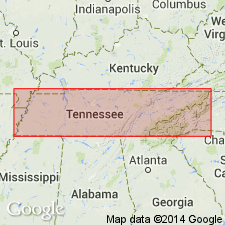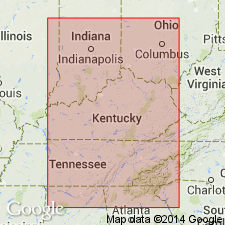
- Usage in publication:
-
- Pierce limestone
- Modifications:
-
- Named
- Dominant lithology:
-
- Limestone
- AAPG geologic province:
-
- Appalachian basin
Safford, J.M., 1869, Geology of Tennessee: Nashville, TN, 550 p.
Summary:
Named Pierce limestone for Pierce's mill, on Stones River, Rutherford Co., TN. Unit is a thin-bedded, flaggy fossiliferous limestone, with generally a heavy-bedded layer near the base. Thickness is 27 feet. The Pierce is included in the Trenton or Lebanon (Stones River) group. It underlies the Ridley limestone and overlies Central (Murfreesboro) limestone. Age is considered Early Ordovician.
Source: GNU records (USGS DDS-6; Reston GNULEX).

- Usage in publication:
-
- Pierce Limestone*
- Modifications:
-
- Overview
- AAPG geologic province:
-
- Cincinnati arch
Summary:
The Pierce Limestone of the Stones River Group in central Tennessee consists of gray to blue gray, dense, very fined grained, thin bedded limestone. Beds are separated by gray calcareous shale partings. The Pierce contains a diverse fauna of brachiopods and bryozoans. Thickness is 23 to 28 feet. Overlies the Murfreesboro Limestone and underlies the Ridley Limestone, both of the Stones River Group. The Pierce was deposited in a quiet subtidal, normal marine environment.
Source: GNU records (USGS DDS-6; Reston GNULEX).
For more information, please contact Nancy Stamm, Geologic Names Committee Secretary.
Asterisk (*) indicates published by U.S. Geological Survey authors.
"No current usage" (†) implies that a name has been abandoned or has fallen into disuse. Former usage and, if known, replacement name given in parentheses ( ).
Slash (/) indicates name conflicts with nomenclatural guidelines (CSN, 1933; ACSN, 1961, 1970; NACSN, 1983, 2005, 2021). May be explained within brackets ([ ]).

